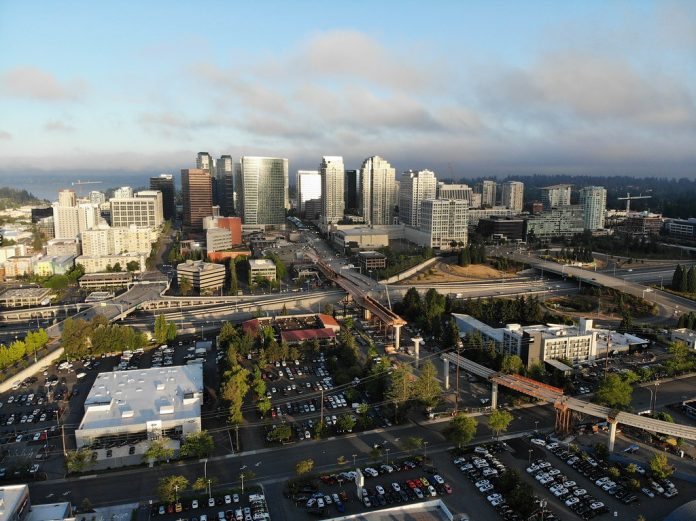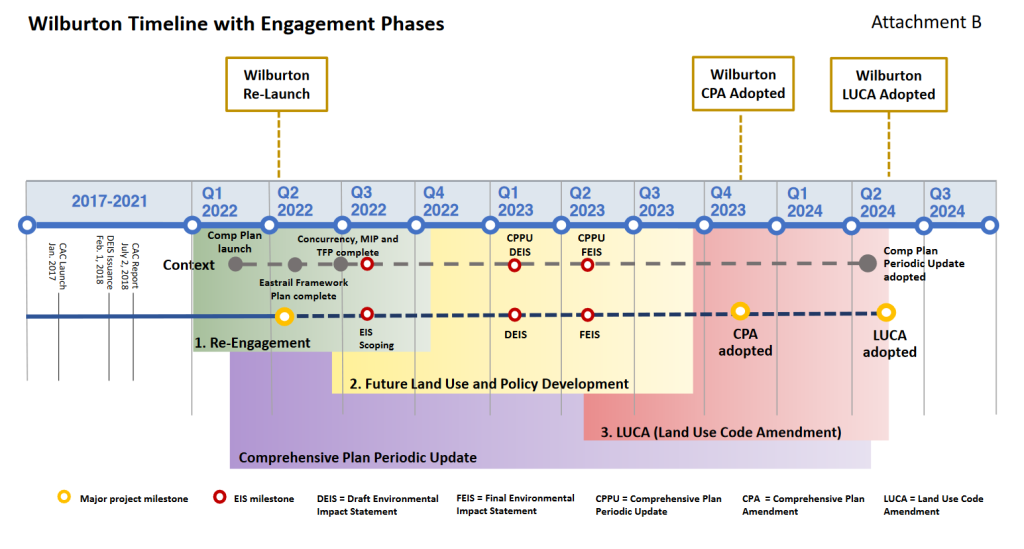
With a unanimous vote on Monday evening, Bellevue City Council directed staff to initiate the planning process for a massive rezone of the Wilburton neighborhood near the Link light rail station opening in 2023. Council also received another update on the Environmental Stewardship Initiative and had an unexpected revisit on rules around remote participation of board and commission members.
Wilburton planning process formally begins
Although future discussions on the area are sure to see conflict and disagreement, there seemed to be one fact that councilmembers, staff, and public commenters at Monday night’s meeting could all agree on: the rezone of the Wilburton neighborhood represents an incredible opportunity to create thousands of transit-oriented housing units alongside vibrant public amenities and trails.
Council decisions and staff’s planning work, slated to last for the next two years, will shape the neighborhood’s development over the next several decades. It’s therefore paramount that the city implement policies that support diverse housing types, prioritize affordable housing to fill Bellevue’s substantial gap, and create sustainable transportation options for people not traveling in cars.
Staff highlighted how the process will take advantage of the simultaneous Comprehensive Plan update to create efficiencies in staff time and complete the project as quickly as possible, but there was still pressure from public commenters and councilmembers to move even quicker than staff’s proposed timeline. Citing the years long process needed for both the recent rezone of East Main and the Wilburton planning initiative, Deputy Mayor Jared Nieuwenhuis commented, “We’re behind on certain aspects. Whenever I hear somebody who wants to be in Bellevue but can’t or somebody who was in Bellevue but isn’t, I’m thinking about these opportunities [to move faster].”

To that end, Councilmember Jennifer Robertson introduced a motion to set the densities put forward in the 2018 report from the Wilburton Citizen Advisory Committee (CAC) as the projected baseline for growth in the corridor, as well as set the scope for the area’s environmental review. This measure could help expedite staff’s deliverables by setting these key policies in place now, instead of later this year after renewed community outreach.
Apart from Councilmember Conrad Lee, who claimed that Council had not had enough time to review or discuss the outcomes of the CAC report, the motion was approved unanimously. Council expects staff to return with more specific dates on when the body will be required to take action or briefed on updates, so hopefully the motion can help facilitate a shorter timeline for this important planning work.
Environmental stewardship: increased budget proposals to come
Because of pressure from community advocates, updates on Bellevue’s implementation of its Environmental Stewardship Initiative (ESI) have become a quarterly tradition for City Council. The spring edition of staff’s presentation highlighted a few sustainability wins, including final adoption of the Mobility Implementation Plan and further implementation of the city’s Green Buildings Support Program. This initiative helps properties apply for state-level green building grants and provides technical support to help buildings comply with Washington state green buildings standards. Staff also highlighted the Bellevue Climate Challenge, a competitive engagement initiative that prompts community members to reduce their environmental impact by changing day-to-day actions.
However, the burden of emissions reductions should not be on individuals — reducing the impacts of climate change will require bolder action from all levels of government. To that end, Councilmembers Janice Zahn and Jeremy Barksdale emphasized their continued desire to evaluate the budget for ESI implementation and potentially increase it to bring on more staff members. Per their direction, ESI staff will return later this year with funding scenarios for different staffing levels that Council can consider. Zahn also asked staff to examine incorporating electrification of the City’s Parks vehicles into discussions around an upcoming parks levy. Other councilmembers’ opinion of this proposal will likely come to light later this summer, when Council is slated to finalize the project list for the November levy.
Remote participation sparks renewed conflict
The evening’s proceedings ended with a slight curveball, as an item previously on the consent calendar was taken off by Councilmember Robertson for further discussion. At their March 22 meeting, Council reconciled disagreements and ultimately moved an ordinance forward that would allow members of City commissions and boards to still participate remotely, albeit with some restrictions. There would be no restrictions on how many times a commissioner could remotely participate (before Covid-19, the restriction was a maximum of four times a year), but a meeting could have no more than three members participating remotely (previously two).
Robertson, who previously voted to support that proposal, said on Monday that the policy did not do enough to restrict people from participating remotely and again cited concerns around ensuring accountability and engagement of commission members. Councilmember Lee, who chose to abstain from the March vote, agreed and emphasized that a commission position represents a commitment to the city and it would need to be honored as such. He concurred with Robertson’s new proposal to bring remote participation more in line with the pre-Covid guidelines and to not allow remotely participating commission members to count towards a meeting’s quorum.
After renewed concerns around equity and inclusion, Deputy Mayor Nieuwenhuis proposed an amendment that would have maintained the night’s original ordinance, but added language to state that in-person participation by commission members was preferred. Councilmember Zahn, drawing parallels with previous comments from Mayor Robinson on universal design, expressed concern about the message that would be sent to disabled community members if the city’s language expressed priority for in-person participation.
“When I think about universal design, it’s not just about physical spaces. It’s about process. It’s about how we create a space of inclusion, however people show up. I am a little concerned that if we put in [language like] ‘preferred in person’ and ‘accommodation’, what we’re really saying is that, if you are someone who is physically not able to attend, then you are treated as ‘less than’ and we have to accommodate you. And that philosophy I just find to be problematic.”
Councilmember Janice Zahn, April 25, 2022
After a visibly frustrated back-and-forth, members united behind a proposal from Councilmember John Stokes to postpone the discussion for a future meeting and directed staff to come back to Council at an unspecified date with a proposal that incorporated councilmembers’ asks around equity and accessibility. Since it seems some Councilmembers’ visions for remote participation are so fundamentally different, it’s unclear if staff will be able to reconcile their competing interests into a proposal that makes all members happy. Until then though, the current rules allowing for unlimited remote participation by boards and commission members will remain in place.
Chris Randels is the founder and director of Complete Streets Bellevue, an advocacy organization looking to make it easier for people to get around Bellevue without a car. Chris lived in the Lake Hills neighborhood for nearly a decade and cares about reducing emissions and improving safety in the Eastside's largest city.


